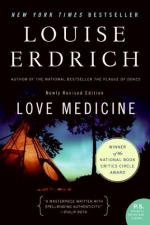|
This section contains 7,705 words (approx. 26 pages at 300 words per page) |

|
SOURCE: Schultz, Lydia A. “Fragments and Ojibwe Stories: Narrative Strategies in Louise Erdrich's Love Medicine.” College Literature 18, no. 3 (October 1991): 80-95.
In the following essay, Schultz explores the function of multiperspectivity in Love Medicine.
In the early part of the twentieth century, multiperspectivity in fiction was seen as elitist and experimental. Many modernist works—T. S. Eliot's The Waste Land (1922), Virginia Woolf's Mrs. Dalloway (1925), William Faulkner's The Sound and the Fury (1929)—use multiperspectival narration to depict the world as fragmentary, disrupted, and chaotic. Modernist uses of multiperspectivity generally draw on “metanarratives” in which one or more characters can control and order the fragments of the world, but only as individuals and with great difficulty. There is no sense that any single perspective can convey cultural truths or that any individual's perception can work toward or participate in a communal vision.
On first glance Louise Erdrich's Love Medicine (1984) seems to...
|
This section contains 7,705 words (approx. 26 pages at 300 words per page) |

|


